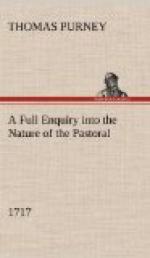Mr. DRYDEN, in another place, has an Observation which carrys the Knowledge of Pastoral still farther. Pastorals, says he, must contain an agreeable Variety after the manner of a Landscape.
But in the GUARDIANS, Vol. I. The Reader may see the Nature of Pastoral more explain’d and enter’d into, in a few Dissertations, than by all these Authors have deliver’d on the Subject. As these are Books in every Bodies Hands, I shall not trouble my self to extract the Summary of ’em. But he will find the Criticism on Phillips and the other Observations are extreamly Ingenious.
CHAP. I
Of the Parts of Pastoral; and of the several Sorts of that Poem.
PASTORAL, in it’s Imitation of the Lives of Shepherds, makes use of FABLE, CHARACTERS, SENTIMENTS and LANGUAGE; and by these four Parts conjoyntly obtain’s it’s End; that is, excites our Pity, or our Joy, or both. For in FABLE I include the MORAL; in SENTIMENTS both IMAGE and THOUGHT; and in LANGUAGE I comprehend the HARMONY.
These four Parts of PASTORAL would lead us into an easy and natural enumeration of the several Kinds or Sorts of that Poem: According as they have more or fewer of those Parts; and as they do or do not excite the Pastoral passions. Not that all those Kinds are perfect Pastorals, or even Poems, but only such as Authors have given us Examples of, from THEOCRITUS and VIRGIL.
But I omit this Division for another more material. A Difference more fundamental, arises in the PASTORALS written by different AUTHORS, according to the Age which the Poet chuses to describe, or the different Descriptions which he gives us of the COUNTRY. For he may draw it as ’tis suppos’d to have been in the Golden Age; or be may describe his own COUNTRY, but touching only what is agreable in it; or lastly, may depaint the Life of Swains exactly as it is, their Fatigues and Pleasures being equally blended together. And this, last Kind most Writers have given into; for Theocritus’s rude unmanner’d Muse (as many Criticks have stiled it, not much amiss) naturally led him into this Method; and then, tis easy to conceive why the latter Pastoral-Writers chose the same.
But as the second Method is plainly more delightful than the last, as it collect’s the most beautiful Images and sweetest Thoughts the Country afford’s; so I shall show that ’tis preferable on many other Accounts; and even finer for Pastoral than the Golden Age. But this when I speak of the Characters.
I would only settle now in short the most compleat Kind of Pastoral; And such, I think, is that which most beautifully draw’s the present Life of Shepherds, and raises Pity or Joy, by the four Parts of Pastoral, Fable, Characters, Sentiments, and Language. And since ’tis these which constitute a perfect Pastoral, I shall crave leave to speak separately of ’em all. And first of the Fable.




